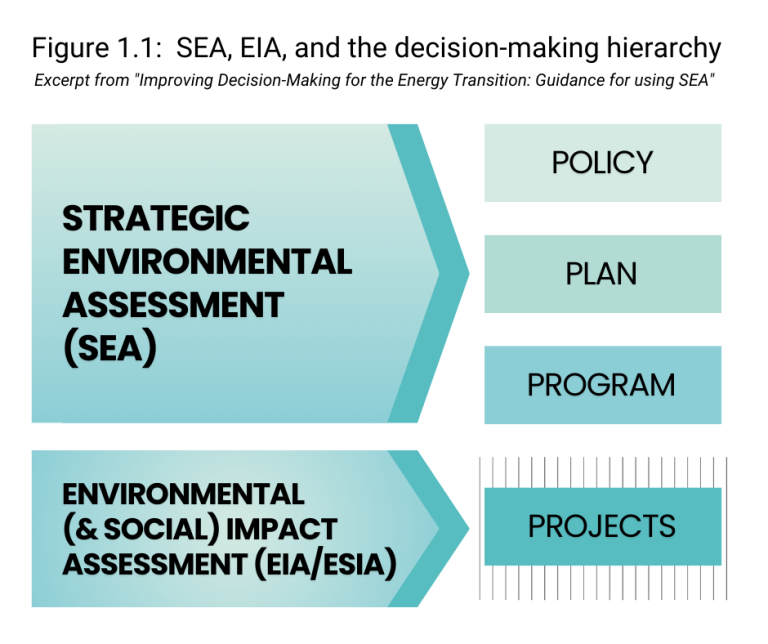Improving Decision-Making for the Energy Transition: Guidance for Using Strategic Environmental Assessment
The first three chapters of the guidance provide best practice guidance for Strategic Environmental Assessment (SEA). Chapter 1 provides a comprehensive background on SEA and its role in supporting sustainable development, particularly in the context of the energy transition. It explains why SEA is necessary to address the broader, long-term potential impacts of policies, plans, and programs (PPPs) that individual project-level assessments (EIAs) do not address. SEA is contrasted with Environmental Impact Assessments (EIA), emphasizing its strategic role in addressing alternatives to policies and plans and identifying how cumulative negative environmental and social impacts could arise if not carefully managed.
The chapter also outlines the principles of SEA, the importance of public and institutional engagement, and how SEA can be integrated into the policy-making process to better manage environmental and social risks. It argues for the flexibility of SEA and provides insights into the challenges of implementation, capacity building, and stakeholder engagement. Key topics discussed in the chapter are below.

What is SEA?
Strategic Environmental Assessment (SEA) helps governments look at the bigger picture when making policies, plans, or programs (PPP) that could affect the environment and people. More specifically, it is a systematic process for incorporating environmental and social considerations across different levels of strategic decision making. It makes sure environmental and social impacts are considered early, preventing harm and encouraging sustainable development. This is especially important for projects related to renewable energy, such as developing hydropower schemes and building wind farms or solar plants.
Why Do We Need SEA?
In the past, governments often focused on individual projects and didn’t think about the combined effects of multiple developments. This led to unexpected problems like environmental damage and social disruption. SEA changes that by looking at the broad and long-term impacts of policies and plans, helping to avoid costly or irreversible mistakes before they are made.
How Does SEA Work?
SEA works by analyzing different options for a policy, program or plan and considering how they might affect the environment and people. It also involves talking to different stakeholder groups, including government agencies, local communities, and businesses, to get their input and ideas. This helps identify the best way to move forward while minimizing negative impacts.
What’s the Difference Between SEA and EIA?
SEA is different from Environmental Impact Assessment (EIA). While EIA looks at the effects of a single project (like building a power plant), in contrast, SEA looks at higher-level policies, plans and programs (PPP) that affect whole sectors, like energy or transportation. SEA also examines how multiple projects within a PPP might cause combined (cumulative) effects on the environment, which EIA typically does not.
Why is Public Participation Important?
SEA encourages input from many people, including local communities and Indigenous groups, to ensure their concerns and ideas are considered. Involving these stakeholders early in the process leads to better, more informed policies, plans, and decisions. SEA also builds capacity by teaching people about environmental and social impacts, which helps improve future projects.
Challenges and Solutions
For SEA to be effective, it needs to happen very early in the policy or planning process so that its recommendations can shape their final focus and content. . Governments often need help from experts to carry out SEA and make sure the results are used in decision-making. Training and public engagement are key to ensuring SEA leads to real, positive changes.
In short, SEA is a powerful process that helps decision-makers plan better for the future, ensuring that PPPs, especially in renewable energy (and the projects that flow from them), are environmentally friendly and socially responsible from the start. This will be key to ensuring a fair, just, and sustainable energy transition.